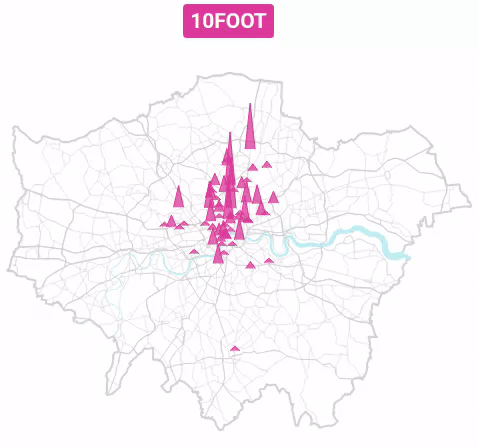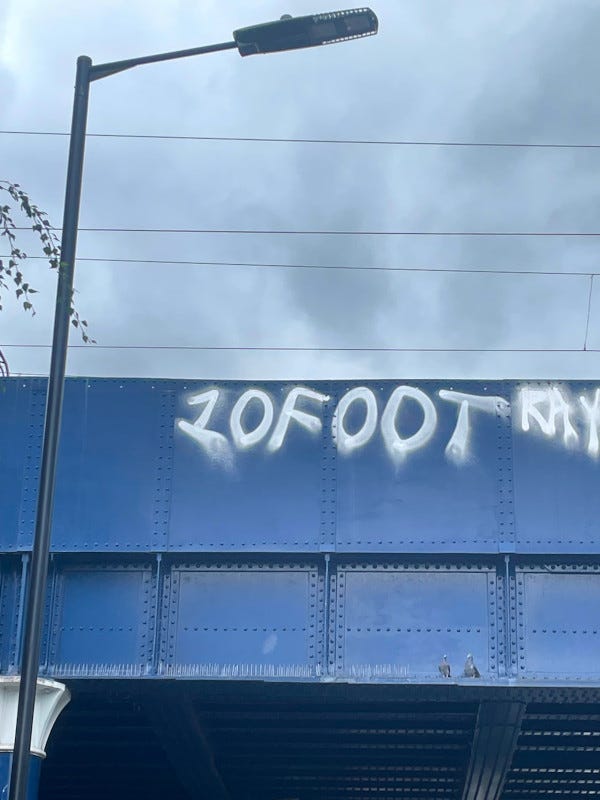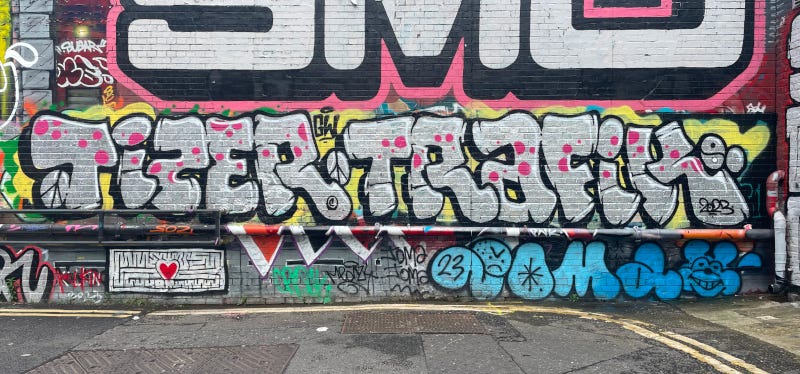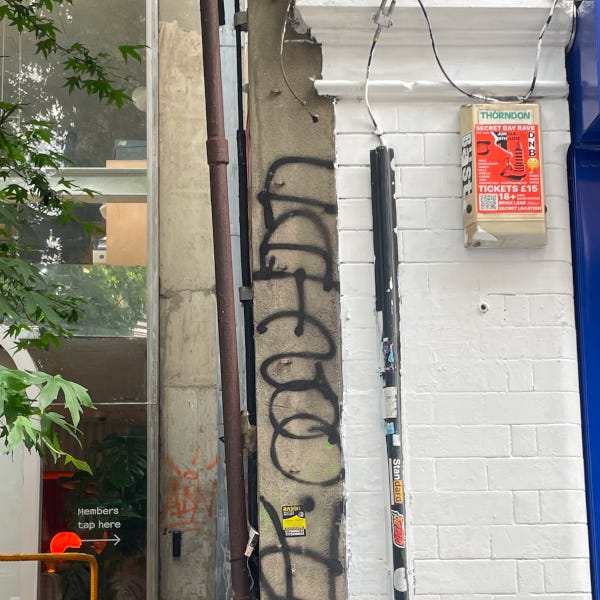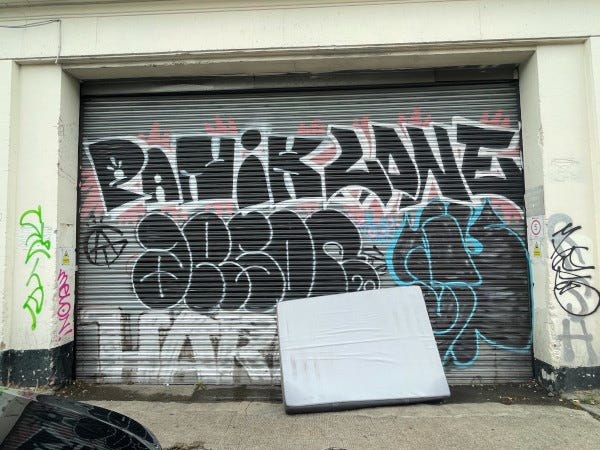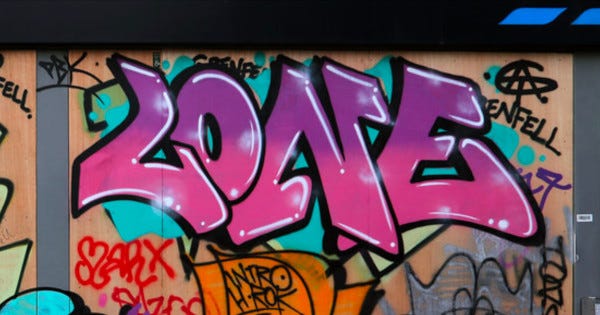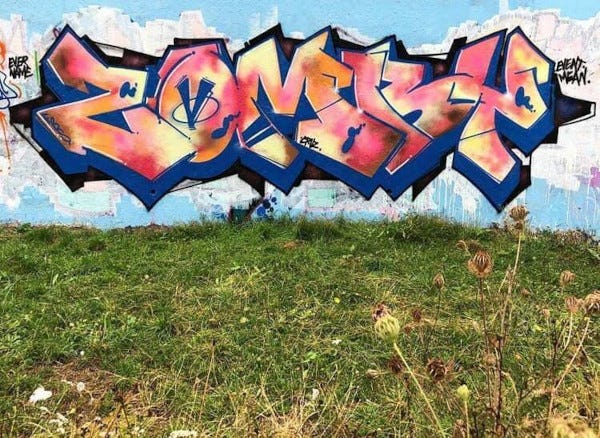Mapped: London's most notorious graffiti writers
Once you know them, you see them everywhere
Morning — today we’re shining a light into a secretive subculture: the world of London’s graffiti writers. We’ve mapped the ten most prolific taggers and attempted to answer: what drives them to risk their freedom and even their life nightly? That’s after your Thursday briefing below.
Plus: water rationing ‘imminent’ for London, blue-on-blue action in the mayoral race, and a new lease of life for one of north London’s megastores.
Consider supporting us: if you’re enjoying the Spy and want to help us grow, you can pledge your support using the button below. You won’t pay anything yet — but you’ll be first in line for a paid version of the Spy when we launch.
P.S. Apologies that you’ve just had one Spy a week in your inbox recently — a few personal matters have got in the way of our sleuthing. We’ll be back to twice-weekly briefings very soon.
What we’ve spied
💧 So much for recent reassurances about London’s water supply — an expert has warned rationing in parts of the city could be ‘imminent’. The prediction came from environmentalist James Wallace, chief executive of charity River Action, as he warned members of the Greater London Authority yesterday they should be treating dwindling water supplies as an “emergency”. He says chalk streams in the Chilterns that feed the capital are drying up, in part due to abstraction, over-use and wastage through leaking pipes. “This means that we are going to be seeing rationing of water in north London imminently. We're not talking 20, 30, 40 years," he said. For its part London’s main supplier Thames Water says it has no plans to ration usage — though the company isn’t exactly doing great at the moment, as it attempts to stave off collapse amid mounting debts. Its interim CEO agrees water use has to change though, and has floated some potential ideas, like charging higher bills to Londoners with big gardens.
🔥 While we’re on environmental doom: a poor assessment this week of the London Fire Brigade’s handling of wildfires that burnt across the city last summer. An internal review published by the LFB found that firefighter shortages meant 39 fire engines weren’t available to help tackle fires on July 19, 2022, which ended up being the LFB’s busiest day on record in modern times amid record temperatures. 16 homes in Wennington, east London, were destroyed by wildfire that day. Other issues the review identified included PPE shortages because “correct laundry processes weren’t being followed”, the absence of a qualified Wildfire Tactical Advisor, and a general lack of planning. Fingers crossed for this year…
🔵 More blue-on-blue action as Conservatives in London start voting on who they want to put up against Sadiq Khan in next year’s mayoral election. One of the contenders, Mozammel Hossain, called out his rival, Susan Hall, to her face in a live debate on LBC for her “intolerant, hateful” posts on Twitter. A “stupid, fat blonde woman,” was Hall’s judgment of TV reality star Gemma Collins when she appeared on I’m A Celebrity In 2014 — a comment that in Hossain’s view means she wouldn’t have wide appeal with London voters. Hall, a London Assembly Member, hit back by saying Hossain, a criminal barrister with no political experience, has no idea how City Hall works. Aside from the heated exchange, Hall has made headlines for promising to scrap 20mph speed limits on main roads. Meanwhile, millionaire donors are apparently flocking to Hossain’s campaign — though they might have a bit of buyer’s remorse after watching his slightly painful interview with GB News where he failed to answer a series of yes or no questions.
🏳️⚧️ Trans+ Pride took place in central London on Saturday, and for the first time it had public support from the mayor. Around 25,000 to 35,000 people attended, making it the biggest since it started in 2018, and Sadiq Khan tweeted on the day: “It's never been more important to support trans people, who are being stigmatised and placed at the heart of a toxic culture war”. Right on cue papers like The Telegraph got in a huff over comments from one of the event’s speakers, Sarah Jane Baker, who told a crowd “If you see a TERF, punch them in the f***ing face”. A spokesperson for the event said: “We do not condone violence, we do not back a call to arms for violence of any kind. We do condone righteous anger and the right to the free speech that was expressed yesterday. We have and will continue to march in peace.”
🎵 Lots of back-patting over the stat that more than a million people attended live music events in London last week. “Music is the glue that binds London together,” said a spokesperson from Music Venue Trust, hailing an estimated £320m in ticket sales from concerts featuring Blur, Bruce Springsteen and Billy Joel across the capital. There are a whispers of a live music ‘revival’ for London — though the Spy would point out that while Wembley and British Summer Time might be weathering the current cost-of-living storm, research in May showed nightclubs were shutting in London at a greater rate than other British cities.
🪑 Some consolation for Ikea fans after the massive Tottenham store closed — the creators of Printworks want to turn the building into a 15,000-capacity cultural venue. Drumsheds is the latest venture from Broadwick, best known for turning a disused printing press in Rotherhithe into a club, and they want to replicate the same strategy in the former Ikea store. With a 15,000-capacity, it’ll be one of the largest indoor venues in the capital, outstripping the 10,250-capacity Alexandra Palace and 12,500-capacity Wembley Area.
🚇 Save the dates — big Tube strikes in two weeks time. London Underground staff have announced they are going on strike over pay on Sunday, July 23 and then for four consecutive days from Tuesday to Friday. Tube drivers are also striking in a separate dispute over pensions and working conditions, joining the walkouts on Wednesday, July 26 and Friday, July 28.
Inside the underworld of London’s most notorious taggers
A quick note: in a first for the Spy, we’ve actually published this story on the web too, to let our visuals sing free from the constraints of email. Definitely worth giving it a look on a computer if you want to see our maps in fullscreen graffitied glory: https://graffiti.thelondonspy.co.uk/
Kbag, Lover and Trip. Those are the graffiti tags of three young men who were killed by a freight train near Loughborough Junction station in south London five years ago. The driver of the train didn’t know it had happened, but their bodies were later discovered with spray cans scattered nearby.
After news broke of their deaths, the three graffiti artists – aged 19, 23 and 23 – were flooded with tributes, both on social media and in paint. “Rest In Paint”, wrote one mourner on Instagram. “Stay safe people, it’s not a game,” said another. Loughborough Junction station was spray-painted with “RIP” and three love hearts.
Things also got nasty. Responding to the deaths, one former TfL board member tweeted to say that the young men were “common scum and criminals who cost the railway millions”. Hitting back, someone sprayed on the station shutters: “f*** BTP' [British Transport Police] and 'f*** TfL.”
The incident offered a rare glimpse into London’s graffiti subculture, a tight-knit community of obsessives willing to risk it all to paint our walls, bridges, trains and overpasses. For many graffiti writers, the more inaccessible or hard-to-reach the location, the better, and risk is an essential part of that equation.
Even so, the individuals behind graffiti don’t tend to get much attention. Often, when we hear about them, it’s because they’ve been caught. In 2016, two members of a graffiti crew called SMT were sentenced to a year in prison, scolded by a judge for “self-indulgent behaviour”. In 2021, another graffiti writer who had sprayed dozens of trains and stations was sentenced to 15 months in prison.
But while most taggers keep their identities secret, a select few have chosen to speak about graffiti publicly. In a YouTube series called ‘Graffiti Kings’, you can watch big names in graffiti chat about everything from getting arrested to what their parents think – usually with a face covering to protect their anonymity.
In a world of big, secretive characters, the Spy set out to find out who exactly the biggest graffiti artists in London are. With thanks to LDN Graffiti, an enormous dataset of almost 50,000 graffiti pieces in London meticulously catalogued by Joe Epstein, we present your guide to the most prolific graffiti artists in the city:
1. 10Foot
Total recorded pieces: 437
Hotspots: Everywhere — but particularly Camden Town, Shoreditch and Finsbury Park
So notorious is 10Foot that when he was arrested several years ago, a police officer asked for his autograph. That’s according to him, anyway, but it’s not entirely far-fetched – his name as London’s most prolific graffiti artist has seen him approached by fashion brands and music labels (but he always turns them down).
10Foot’s tag is on bridges, overpasses, shutters, windows, bus stops and all over London’s network of side-tracks and train carriages — sometimes in elaborate fonts, other times as quick scrawls. Partly key to his success is quite literally the maintenance keys he’s nabbed from rail control rooms, giving him access to tunnels. Well there’s that, and the fact that he’s very tall. “I’m just called 10Foot cos I was always really tall,” he explained in an interview with the Financial Times.
His antics have earned him a substantial criminal record. He’s been convicted for committing over £100,000 in criminal damage and jailed for 26 months. He also claims never to pay for his own paint — instead he steals it (Wickes is his shop of choice). Jail time hasn’t stopped him, though, and he’s still active.
2. 2Rise
Total recorded pieces: 312
Hotspots: Shoreditch, Stockwell, Hackney
Originally from Melbourne, 2Rise moved to London over 10 years ago for graffiti, (or “graf” – as he calls it). “I came here on holiday and was like right this is sick,” he said in a Graffiti Kings YouTube video. He describes graffiti as “the destructive side of [himself]”, coming hand in hand with drinking and going out. He often finds himself in chases, which he enjoys, claiming they’re “one of the more exciting parts about graf”.
2Rise is known for being quick. “I paint better and have more fun when I paint a bit quicker. If you try too hard at anything it comes out shit,” he says. And his style reflects this: “I enjoy fat caps, and I enjoy long lines” he explains. “I enjoy that more than fiddling around with more detailed stuff”. Amongst his influences he cites Tizer, Zomby and Teach, with Tizer (see below) being someone who has actively “pushed” him to advance his style.
Outside of talking about style, he’s critical of the way that graffiti is policed compared to other crimes. “In London the government is putting people in jail longer for graf than for all sorts of mad offences. People are getting in knife fights, sexual assault, acid attacks, billionaire tax evasion bullshit, embezzlement, all of that. And then there’s some dude who’s pumped a couple of panels and they’re like boom, that's two years”.
3. Tizer
Total recorded pieces: 287
Hotspots: Shoreditch, Waterloo, Stockwell
Tizer has been active on the London scene since the late 80s, having moved to the UK as a child from Omaha in Nebraska. In his early days, Tizer says he was influenced by the hip-hop movement and some of the illegal murals in Brixton, but he also says he studied calligraphy and ancient writing to develop his tags.
The name Tizer is based on an old-school fizzy drink made by Barr, which had the tagline “the great British pop”. It’s not really a thing anymore, but you can still buy it on Amazon. Explaining the name, he said: “I chose Tizer because it’s a British drink and I’m a British graffiti writer, and I wanted people to realise that I was a British graffiti writer even though I don't sound like I’m from here.”
4. Fatso
Total recorded pieces: 266
Hotspots: Tottenham, Camden Town, Dalston
There’s very little information out there about Fatso, but he is rumoured to work in a trio alongside 10Foot and Jason. “Saw all three of them doing the underpass outside Peckhamplex on Monday as it goes”, said someone on Reddit.
5. Panik
Total recorded pieces: 198
Hotspots: Kentish Town, Camden Town, Shoreditch
Panik is not only known for his own art but for being one of the co-founders of ATG, a.k.a. The Antagonizers, which is one of the most notorious graffiti crews in the country. He set up the group in 2001 with friends who were loosely connected through selling weed and shared the common goal of pushing the graffiti scene forward north of the river.
“ATG was and always will be a lot about partying as well as painting which is how we spread so quickly. We would go to random parties all over the city and then after when we were all charged up we would climb all over shit, bombing our way home,” he said.
He’s also talked about graffiti as an addiction. “If you’re in it for the long haul then it is all about how to tame that addiction in a way that allows you to get on with the rest of your life,” he says. He didn’t always stick to painting in the streets, though. He also displayed his work in gallery shows, such as a solo one at Pure Evil Gallery that he was interviewed about in 2010.
6. Lone
Total recorded pieces: 190
Hotspots: Finsbury Park, Tottenham, Camden Town
Unfortunately Lone and the following three taggers — Heato, Diet, and T32 — are true unknown quantities. Try as we might, the Spy couldn’t find anything about them online — perhaps a sign of how closely they guard their identities. Still, from the data we’ve gathered, they’re amongst the top ten in the city, each with their own stomping grounds.
7. Heato
Total recorded pieces: 178
Hotspots: Camden Town, Shoreditch, Finsbury Park
8. Diet
Total recorded pieces: 174
Hotspots: Kensington, Finsbury Park, Tottenham
9. T32
Total recorded pieces: 164
Hotspots: Elephant & Castle, Finsbury Park, Camden Town
10. Zomby
Total recorded pieces: 162
Hotspots: Kensington, Shoreditch, Hackney
Described by some as graffiti “royalty”, Zomby has been active on the scene since 1986. He played a pivotal role in one of London’s most notorious graffiti crews, DDS (or Diabolical Dubstars), which is now said to have several different chapters and hundreds of members, including 10Foot amongst others.
It’s not surprising, then, that Zomby was one of the names on display when the Saatchi Gallery put on an exhibition dedicated to worldwide graffiti earlier this year. Speaking to the Face magazine at the event, he commented on how graffiti has changed: “Back in the ‘80s and ‘90s, people thought: This is just a fad, and it will just die out. They’re just vandals.”
Now, he says, graffiti artists are getting recognition via collaborations with brands. “Graffiti writers and the culture are getting recognition. The up [prolific] writers are like heroes. It gives the clothing brands a little boost, and it gives us money and gets our work out there. A win-win for both parties…”


